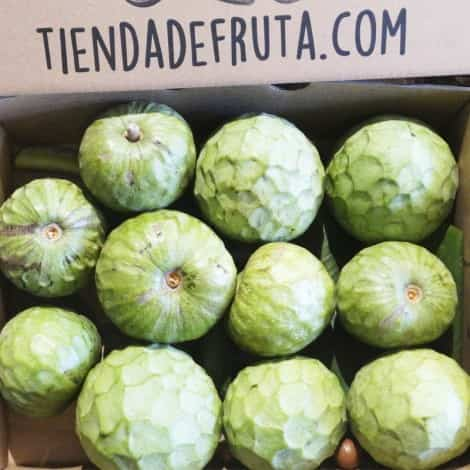- On sale!









(€6.25 kg)
Wonderful cherimolas box, around 4,5kg. 12 to 16 pieces depending on the size. The cherimolas are grown in centenary trees planted by my grandfathers dad
Cherimoyas are difficult to ship during winter time therefore we don't recommend shipping this product abroad between december and february. It will be at your own risk if you order out of these dates, no refund will be made in the event of damage upon arrival
Please note: All international shippings are sent ONLY on mondays, if done during the week it will be delivered the following Monday, beware of spanish bank holidays
The Custard Apple, Anona Cherimola is a tropical fruit adapted to the microclimate of Almuñécar and the Costa Tropical. It is the only fresh fruit with Protected Designation of Origin in Andalusia D.O.P.
It is a very cold-sensitive tropical fruit that tastes like a mixture of pineapple, banana and mango; it is very aromatic and valued for its numerous diuretic and depurative properties as well as its antioxidant properties. It contains a lot of potassium (K), magnesium (Mg), iron (Fe) and zinc (Zn) as well as a lot of vitamin C. It is very low in fat.
Thanks to its fibre, niacin and cytotoxin content, it is a powerful natural antimicrobial, perfect for your children's health. It is very satiating and contains many nutrients that help development during pregnancy as well as regulating blood glucose levels.
How to eat it is easy: cut the fruit in two halves and remove the stem that holds the fruit to the tree, then with a spoon and eat it like a yoghurt.
How to know when it is ripe: when you touch it, you will see that the skin is softer and you will see that the trunk that attaches it to the tree has also separated a little from the fruit and the colour of the skin is fainter.
How to keep it: due to its delicate and thin skin, it is advisable not to keep it in the refrigerator, as it will turn black and cut off the ripening process.
in our area the fruit starts to ripen at the beginning of September and lasts until the end of April.
The ripeness of the fruit depends on its setting during pollination and the area in which the cherimoya plant is located. If it is located on a hillside, it will have less humidity than if it is in a lowland area.
The custard apple is one of the hallmarks of Almuñécar, and can be enjoyed in a cheerful ice-cream at the La Italiana ice-cream parlour in the town of Almuñécar.
As it is such a versatile tropical fruit, it is ideal for your smoothies or nutritious shakes, you only have to strain the seeds (you can centrifuge them with the butterfly in a Thermomix or other food processor), add a little water or coconut milk and accompany it with fresh pineapple or a drop of lime.
Another excellent option to surprise your family and friends is a custard apple mousse cake.
It is also possible to infuse custard apple leaves to combat anaemia or enjoy its relaxing effects.
For all these reasons we encourage you to buy custard apples in our online shop, directly from farmer!
The custard apple tree belongs to the anonaceae family, it is a survivor of past times and originated in Central America. It arrived in Almuñécar - La Herradura as part of a plan to adapt species from the New World to our area in the 18th century.
There is a theory that due to the humidity trapped in the valleys of our coast when it comes up against the wall of the Sierra de la Almijara, it recreates the limit conditions for the development of the plant, stressing it so much that it thinks it is dying and when it realises in spring that it has not done so, it produces the best possible fruit to ensure the survival of the species.
On our farm we harvest it at its optimum point of ripeness, which means that we shake the fruit every day to visualise the fruit's fattening and tone. When the cherimoya starts to change to a whiter shade and the buds start to swell, we know that it is time to harvest
However, we randomly check the brix level to check the sugar concentration. The fact that it is a climacteric fruit means that the fruit ripens from the moment it is harvested, which means that it must reach a state of maturity on the tree, and that the optimum edible point will be reached a few days after harvesting.
As the custard apple is such a perishable fruit, it will be sent the same day it is harvested to prevent it from deteriorating during the journey by courier; you will be able to enjoy this delicacy 3-4 days after harvesting.